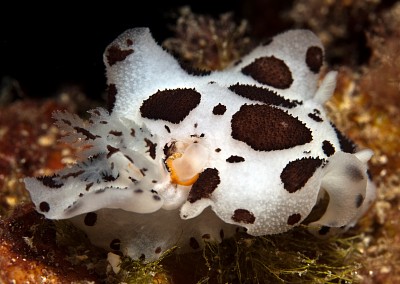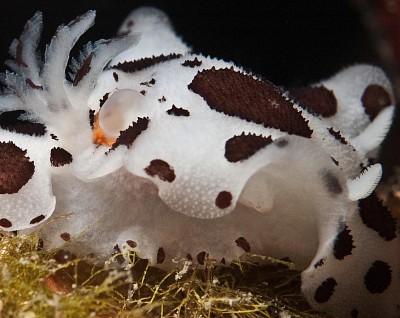Peltodoris atromaculata abnormality
September 9, 2009
From: Antoni López-Arenas i Cama


Dear Bill,
We found this specimen of Peltodoris atromaculata on a day the current was flowing strongly. I think that is the reason I could take photographs of its gills expanded and the undulating mantle, but I'm not really sure...
Do you think that the protuberance surrounded by a yellow ring is a reproductive organ in a wrong place or another abnormality?
Locality: Costa Brava, Tossa de Mar., 23 metres, Spain, Mediterranean, 29 August 2009, Pre-coraligen. Length: 5 cm. Upper Photos: Antoni Lopez-Arenas i Cama. Lower Photo: Marc Bosch
Thank you and best wishes,
Antoni Lopez-Arenas i Cama.
http://bitxosdelmediterrani.blogspot.com
http://www.flickr.com/photos/alopezarenas/sets/72157603891082971/
alopezarenas@gmail.com
López-Arenas, A., 2009 (Sep 9) Peltodoris atromaculata abnormality. [Message in] Sea Slug Forum. Australian Museum, Sydney. Available from http://www.seaslugforum.net/find/22636
Dear Antoni,
I first thought this might be an example of a parasitic crustacean, but the damage to the mantle is quite extensive so I suspect that it is the result of a predator's bite. Interpreting anatomical peculiarities from photos is a bit risky, but I suspect the thin-walled 'balloon' which is poking out is part of the pericardium, which is a blood-filled sac surrounding the heart. The heart is just beneath the surface and just in front of the gills. The heart is very close to the gills because one of its main functions is to pump oxygenated blood around the body - and the gills is where oxygen from sea water is transferred to the blood. If you look at a dorid, you will often see a small swelling in front of the gills which is pulsating - that is the heart at work. I suspect the orange ring around the 'balloon' is the kidney - although I am puzzled by its colour. The kidney forms a layer just below the mantle in the same area. Its function is similar to our kidney. The other possibility is that the orange tissue is the blood gland, which is a thin flattened gland which is often over-looked in dissections. Various functions concerning the blood have been suggested for this organ, but unless I have missed some recent work, we really don't seem to know what its real function is.
So in summary, I think the thin-walled balloon is part of the pericardial sac which has popped out when something bit away a part of the slug's body wall.
Best wishes,
Bill Rudman
Related messages
-
Re: Peltodoris atromaculata with damaged mantle
From: M. Baki Yokes, June 12, 2009 -
Re: Peltodoris atromaculata with damaged mantle
From: Dominique Horst, May 27, 2009 -
Peltodoris atromaculata from North Cyprus
From: Carol Cox, April 8, 2008 -
Peltodoris atromaculata from southern Portugal?
From: Pedro Alexandrino Monteiro, August 11, 2007 -
Discodoris atromaculata feeding
From: Anne Kloeppel, June 7, 2007 -
Discodoris atromaculata from Croatia
From: Gearoid Lane, March 30, 2006 -
Discodoris atromaculata on Petrosia ficiformis
From: Stephane Ores, January 13, 2006 -
Re: Discodoris atromaculata from Greece
From: Andrej Jaklin, February 25, 2004 -
Re: Discodoris atromaculata from Greece
From: Baki Yokes, February 24, 2004 -
Discodoris atromaculata from Greece
From: Mihalis Polyadis, February 23, 2004 -
Discodoris atromaculata from Adriatic
From: Adam Petrusek, October 8, 2003 -
Discodoris atromaculata from Holland
From: Andy den Boer, July 1, 2003 -
Discodoris atromaculata egg-ribbon
From: Marina Poddubetskaia, July 28, 2002 -
Discodoris atromaculata from France
From: Marina Poddubetskaia, June 28, 2002 -
Discodoris atromaculata from Greece
From: Fons Sarneel, March 19, 2002 -
Discodoris atromaculata from Greece
From: Peter H. van Bragt , April 29, 2001 -
Re: Food of Discodoris atromaculata
From: Juan Vicente López-Canales, February 15, 1999 -
Re: Photo of Discodoris atromaculata
From: Erwin Koehler, February 1, 1999 -
Food of Discodoris atromaculata
From: Juan Vicente López-Canales, January 28, 1999
